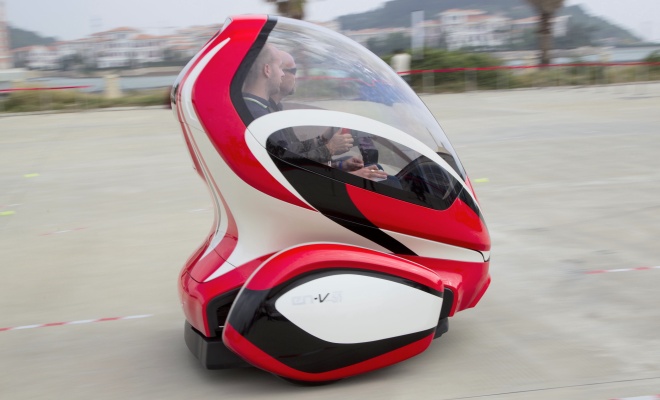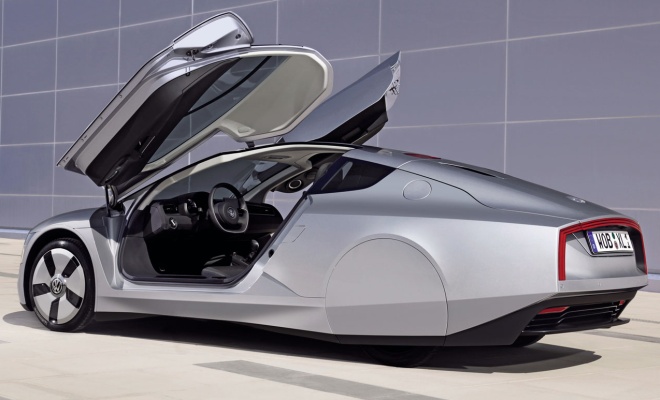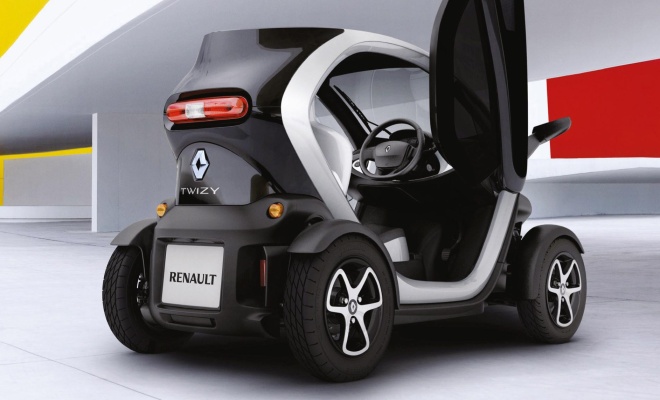Over the last couple of years motor manufacturers have shown off a surprising variety of concepts designed to set aside the conventions of traditional cars. The aim has been higher fuel economy or lower carbon impact, compact dimensions for urban nippiness, and looks that demand a double take.
I've rounded up a few of my favourites for a quick hit parade of future mobility solutions.

10. Volkswagen Nils
Propulsion: battery electric, rear-wheel drive
Doors: gullwing
Seats: 1
Wheels: 4
Weight: 460kg
Chances of production: low
Quirkiness: high
The VW Nils concept features a rear-mounted motor rated at 15kW (20bhp) in continuous operation, or 25kW (33bhp) in short bursts. Feeding the motor is a 5.3kWh lithium-ion battery that provides enough power for a quoted range of 45 miles, or a top speed of 80mph. The body is an aluminium space frame clad in aluminium and plastic panels.
One noticeable feature is the lack of seats: this concept is the least sociable car in this list, capable of carrying only its driver plus a modest quantity of luggage. While this does confer a certain purity of purpose, not to mention allowing the driver to indulge in single-seat racing fantasies, it does make the Nils the least practical car here, relegating it to last place in my quirky-car hit parade.

9. General Motors EN-V
Propulsion: battery electric, all-wheel drive
Doors: rear-hinged canopy
Seats: 2 abreast
Wheels: 2
Weight: 400kg
Chances of production: miniscule
Quirkiness: stratospheric
Jointly developed by General Motors and Segway, the EN-V balances on its hind wheels through the miracle of computers and accelerometers.
The EN-V can hit a maximum speed of 25mph and offers a maximum range of 25 miles. Lithium-iron-phosphate batteries with 3.2kWh capacity power four in-wheel motors, adding up to an 18kW (24bhp) maximum. The carbon fibre and acrylic bodywork, plus the Lexan canopy bubble, ride on a magnesium, aluminium and stainless steel chassis.
The EVN-V is a development of the earlier, more skeletal Segway Puma. It may be a remarkable showcase for advanced automation, telematics and drive-by-wire technology, but it would need a dramatic change in legislation to be legal on European roads.

8. KTM E3W
Propulsion: battery electric, rear-wheel drive
Doors: Lamborghini-style scissor-action
Seats: 2 abreast
Wheels: 3
Weight: 380kg
Chances of production: Good
Quirkiness: a bit too high
KTM’s E3W is a plastic-bodied three-wheeler dreamed up by Austrian motorcycle maker KTM, in collaboration with the Austrian Institute of Technology and Kiska, the design studio responsible for KTM’s other non-motorcycle, the X-Bow bare-bones sports car.
Powered by a modest 15kW (20bhp) electric motor and 6.5kWh lithium-ion battery, the E3W is predicted to have a range of around 60 miles and a top speed of around 60mph. Seating is for two, in a conventional, two-abreast arrangement.
Not the prettiest design to come out of the Kiska studio, but ought to be reasonably affordable. Two-abreast seating does mean a UK-spec, right-hand-drive version would require extra work and investment.
Despite its attention-grabbing Lamborghini-style doors, on this list, the E3W looks a little crude and unexciting. Perhaps it’s that lonely little rear wheel that undoes it, making the E3W look a little like a beachball perched on a moped.

7. Opel RAKe
Propulsion: battery electric, rear-wheel drive
Doors: Front-hinged canopy
Seats: 2 in tandem
Wheels: 4, but with a narrow 60cm track at the rear
Weight: 380kg
Chances of production: very low
Quirkiness: high
This is another Kiska design, like the KTM above. The Opel RAKe boasts a 60-mile range and 75mph top speed from its rear-mounted motor and 5kWh lithium-ion battery. Rated at 10.5kW (14bhp), short bursts of up to 36.5kW (49bhp) would also be possible for extra acceleration.
With its narrow rear giving a basically tricycle layout, the RAKe is not the most practical concept here, although it does have room for a passenger behind the forward-folding driver’s seat. As with the bubble-cars of the 1960s, the steering column tilts out of the way when the canopy is opened.

6. Peugeot-Citroen VELV
Propulsion: battery electric, rear-wheel drive
Doors: conventional lower section, gullwing upper section
Seats: 2+1; a central driver's seat plus an asymmetrical rear bench
Wheels: 4 in tricyle layout
Weight: 650kg
Chances of production: low
Quirkiness: very high
VELV stands for Véhicule Électrique Léger de Ville, or lightweight electric city vehicle. An 8.5kWh lithium-ion battery and 20kW (27bhp) electric motor furnish a top speed of 110km/h (68mph) with a range of 100km (62 miles) on a single charge. A pair of Michelin supplied hub motors drive the closely-spaced rear wheels.

5. Nissan Land Glider
Propulsion: battery electric, rear-wheel drive
Doors: ordinary front-hinged doors
Seats: 2 in tandem
Wheels: 4
Weight: unknown
Chances of production: moderate
Quirkiness: very high in corners
One of the oldest of this crop of concepts, the Land Glider was unveiled at the Tokyo motor show in 2009. It has a fabulous bubble canopy, sports an aircraft-style steering wheel and leans into corners like a motorbike, but is otherwise relatively tame in the present company. Nissan officials have told me twice in the last couple of years that the Land Glider was not just a show-car fantasy but is the subject of a proper engineering project with the aim of producing an upmarket, roadgoing vehicle. Technical details remain sketchy - we know the show car was powered by lithium-ion batteries and propelled by twin rear motors. Beyond that, it’s all guesswork.

4. Audi Urban Concept
Propulsion: battery electric, rear-wheel drive
Doors: rearward sliding canopy
Seats: 2, passenger staggered to the side and behind the driver
Wheels: 4
Weight: 480kg
Chances of production: very high
Quirkiness: high
Shown off in both hard-top and open-top form, the Audi Urban Concept may have the dullest of names but should deliver real thrills on the road. Even the fixed-head version can be driven with the canopy slid back and pegged open. A 7.1kWh lithium-ion battery provides a range of up to 45 miles and speeds up to 100km/h (62mph).
Propulsion is via a pair of rear-mounted motors capped at just 15kW (20bhp), although it’s likely this lowly figure was chosen simply to cater for the continental licence-exempt category for young drivers. The narrow tub seats two, just about, and is fabricated from a mix of carbon fibre and aluminium.
Reportedly, Audi will build a limited production run of 999 Urban Concepts priced at €9,999, hopefully with a bit more poke.

3. Murray T25/T27
Propulsion: rear-wheel drive; petrol engine (T25) / battery electric (T27)
Doors: nose-hinged canopy, side-hinged rear hatch
Seats: 3; a central driver's seat plus two rear seats
Wheels: 4
Weight: 550kg(T25)/680kg(T27)
Chances of production: moderate
Quirkiness: very high
Smaller than a Smart ForTwo but seating three in reasonable comfort, this pair of experimental cars are rolling demonstrators for Gordon Murray’s unconventional iStream production process. An inexpensive chassis of tubes and sheet metal is clad in unstressed plastic panels.
Small size and light weight give astonishing economy and/or range, despite relatively small powerplants. In T27 electric car format it uses a 12kWh lithium-ion battery and 25kW motor to give a top speed of 105km/h and 100 mile range. Meanwhile, a 660cc turbo petrol from Mitsubishi powers the T25, delivering a measured 96mpg in the 2010 Brighton-to-London Future Car Challenge.

2. Volkswagen XL1
Propulsion: diesel-electric plug-in hybrid, rear wheel drive
Doors: forward-lifting gullwings
Seats: 2, slightly staggered
Wheels: 4
Weight: 795kg
Chances of production: high
Quirkiness: high
The sleek XL1 features an 800cc two-cylinder turbo-diesel engine developing 48bhp (35kW). This unit - essentially half an ordinary VW four-pot - is coupled with a 7-speed twin-clutch gearbox alongside an electric motor producing 27bhp (20kW). Much of the body is fashioned in carbon fibre, and its slender cigar shape results in a drag coefficient of just 0.186. The lithium-ion batteries can be charged from the mains, yielding a zero-emissions range of 35km. Top speed is capped at 99mph (160km/h).
The widest but also the most practical of VW’s ultra-efficient experimental vehicles, after the 1-Litre and L1 concepts, the XL1 is also the first to look production feasible. Hopefully we will hear news of a green light for production in the near future.

1. Renault Twizy
Propulsion: battery electric, rear-wheel drive
Doors: scissor-style side barriers
Seats: 2 in tandem
Wheels: 4
Weight: 450kg
Chances of production: it’s being built, on sale in the UK from spring 2012
Quirkiness: off the chart
Equipped with a 15kW (20bhp) motor, the Twizy’s top speed will be 50mph, average range about 60 miles. The doors have no windows, so the Twizy will be permanently open to the elements.
The 6kWh, 100kg battery is mounted low, keeping the Twizy more planted in corners than you might expect from its tall and narrow stance. According to the lucky motoring journalists who’ve driven the prototype, it’s an absolute hoot to drive.
Prices will start at £6,690 plus £40 per month to lease the 6kWh battery. If that sounds appealing, you can pre-order a Twizy now for £20.



